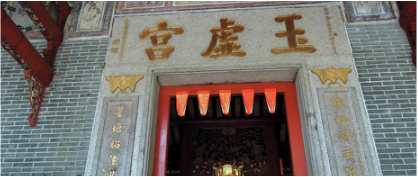Yuk Hui Temple is located in Lung On Street, Wan Chai. The Pak Tai Temple was built by local residents in 1863 for the worship of the Taoist deity Pak Tai (北帝), Emperor of the North, also known as Yuen Tin Sheung Tai (玄天上帝), the Supreme Emperor of the Dark Heaven. Pak Tai was a brave warrior who had once defeated the Demon King (魔王) of the Shang (商) dynasty. The deity was very much worshipped by fishermen but has become less popular after the World War II.
The temple, originally called "Yuk Hui Kung", is now listed as Listed as Grade I historical building by the Antiquities Advisory Committee for permanent preservation. It was initially kept by a Kaifong Worship Committee in Wan Chai and later managed by the Chinese Temples Committee (CTC) since 1928.
The temple, originally called "Yuk Hui Kung", is now listed as Listed as Grade I historical building by the Antiquities Advisory Committee for permanent preservation. It was initially kept by a Kaifong Worship Committee in Wan Chai and later managed by the Chinese Temples Committee (CTC) since 1928.
ImPORTANCES |
Architectural features:
Yuk Hui Temple is one of the biggest temples on Hong Kong Island and one of the two biggest Yuk Hui temples (the other is the Yuk Hui Temple in Cheung Chau) in Hong Kong. It still contains many valuable architectural features and antiquities after several repairations. The main temple is a two-hall building separated by a covered courtyard in between the front and rear halls, with both flush gable and hip-and-gable styles. The ceramic ridge was decorated with a pair of dragon, a firing pearl, two aoyus (鰲魚, dragon fish), figurines of Chinese opera, floral patterns, etc. Those were made by a Shiwan kiln dated 1907 are still kept in good condition. The granite columns and the wooden brackets are elegantly engraved with ornate carvings. The oldest antiquity in Yuk Hui Temple is the Cooper statue of Pak Tai and it is located in the covered courtyard. The Cooper statue of Pak Tai cast in Wangli regin of the Ming Dynasty (1604). Another antiquity in Yuk Hui Temple is a Copper bell which cast in the 2nd year of Tongzhi regin of the Qing Dynasty (1863). |
|
Relations with community:
Yuk Hui Temple had a strong relation with the Wan Chai community since it was erected.The prime of the temple was during the pre-Second World War period. In the 19th Century, Wan Chai was near the seashore and residents in Wan Chai mostly were fishermen. Pak Tai was very much worshipped by the fishermen as people believe that he has the spiritual power to abate disasters. Therefore, many fishermen visited the temple for safety before they went to work. The temple was also a social gathering place for residents in Stone Nullah Lane, particularly during festivals. In 1950s, the living condition of Stone Nullah Lane were quite poor, therefore the St. James Settlement has set up a Children's Club at Chinese Temple in Stone Nullah Lane Started by Bishop R.O. Hall (Anglican Bishop of Hong Kong) in the left block of Yui Hui Temple (it was named Kung Sor at that time, and it is named Hall of Lung Mo now). The St. James Boys’ and Girls’ Club provided education to children lived nearby. From this, we can see there is linkage between Yuk Hui Temple and Wan Chai community. With the decline of fishing industry in the district and the improved social welfare policy in the following years, Yuk Hui Temple has less linkage with the community but many people go to the temple for worshipping Pak Tai. |
|
HOw To go there??
YUI HUI TEMPLE
Address: 2 Lung On Street, Wan Chai, Hong Kong
Opening Dates and hours:
Daily 8 a.m. to 5 p.m.
Public Transport:
- By MTR - Wan Chai Station A3 Exit. Cross Johnathan Road andpass through Tai Yuen Street. Then cross Queen's Road East, walk up Stone Nullah Lane, and turn left onto Lung On Street
- By Tunnel Bus nos. 109 & 113 or Bus nos. 6, 6X, 10, 15, 61 & 66 - get off at Wu Chung House (westbound) or Wan Chai Market (eastbound)
Address: 2 Lung On Street, Wan Chai, Hong Kong
Opening Dates and hours:
Daily 8 a.m. to 5 p.m.
Public Transport:
- By MTR - Wan Chai Station A3 Exit. Cross Johnathan Road andpass through Tai Yuen Street. Then cross Queen's Road East, walk up Stone Nullah Lane, and turn left onto Lung On Street
- By Tunnel Bus nos. 109 & 113 or Bus nos. 6, 6X, 10, 15, 61 & 66 - get off at Wu Chung House (westbound) or Wan Chai Market (eastbound)

